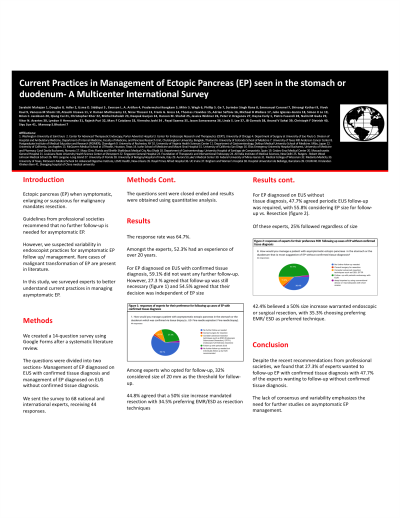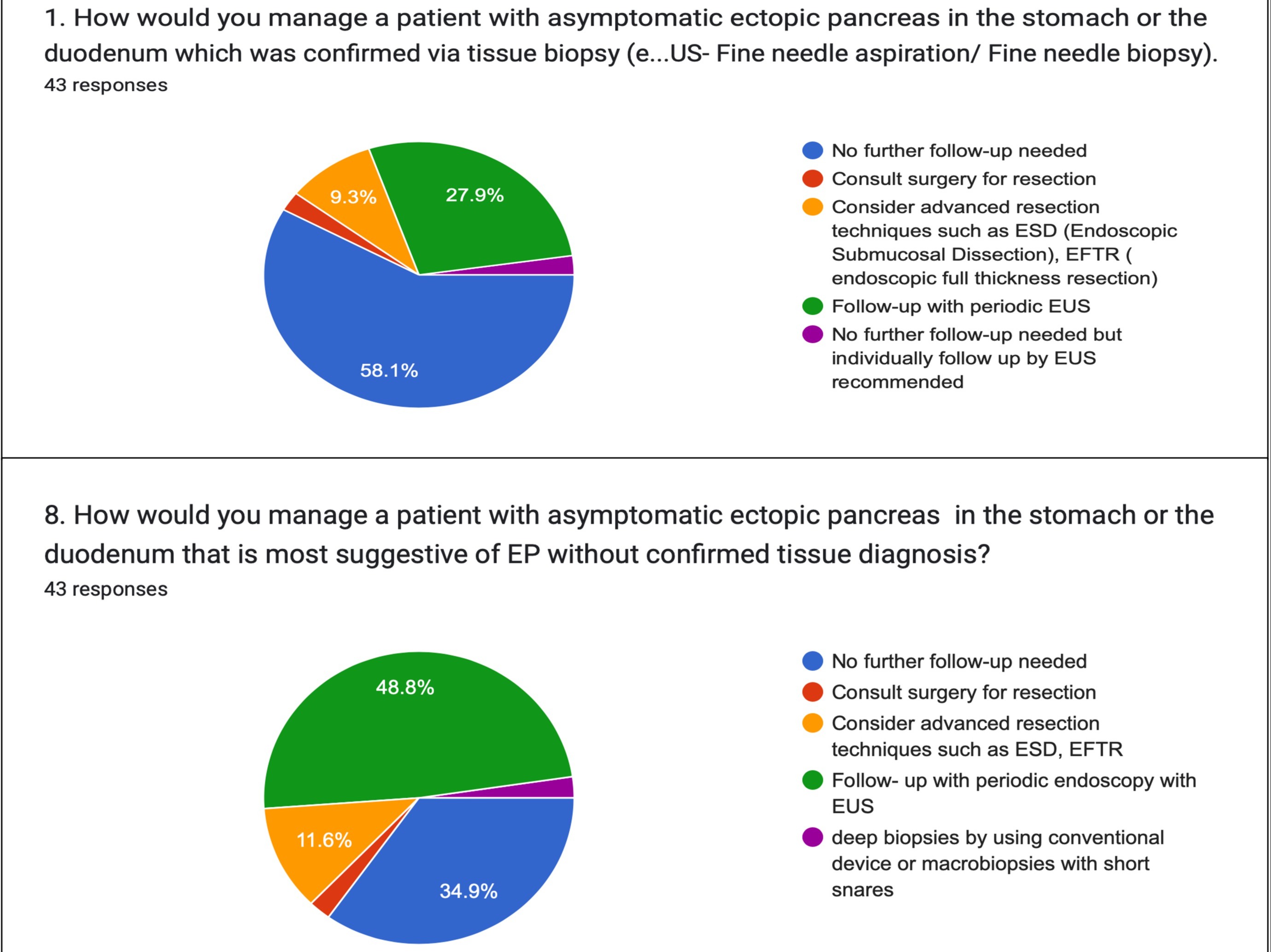Tuesday Poster Session
Category: Practice Management
P4077 - Current Practices in Management of Asymptomatic Ectopic Pancreas Seen in the Stomach or Duodenum
Tuesday, October 24, 2023
10:30 AM - 4:00 PM PT
Location: Exhibit Hall

Has Audio
- SM
Sarakshi Mahajan, MD
University of Arkansas Medical Sciences
SAINT LOUIS, MO
Presenting Author(s)
Sarakshi Mahajan, MD1, Sun Siyu, MD, PhD2, Manoop S. Bhutani, FASGE, FACG, FACP, AGAF3
1University of Arkansas Medical Sciences, Little Rock, AR; 2ShenJing Hospital of China Medical University, Shenyang, Liaoning, China; 3MD Anderson Cancer Center, Houston, TX
Introduction: Ectopic pancreas (EP) when symptomatic, enlarging or suspicious for malignancy mandates resection. However, asymptomatic EP in stomach or duodenum lacks clear guidelines for management and follow-up. Some endosonographers prefer no intervention or follow up, some prefer periodic EUS/EGD and some resection. In this study, we surveyed experts to understand current practices in managing asymptomatic EP.
Methods: We created a 14-question survey using Google Forms after a systematic literature review. The questions were divided into two sections- Management of EP diagnosed on EUS with confirmed tissue diagnosis and management of EP diagnosed on EUS without confirmed tissue diagnosis.We sent the survey to 74 national and international experts, receiving 43 responses. The questions sent were closed ended and results were obtained using quantitative analysis.
Results: The response rate was 58%. Amongst the experts, 51.2% had an experience of over 20 years.For EP diagnosed on EUS with confirmed tissue diagnosis, 58.1% agreed no further follow-up was necessary (figure1) and 53.5% agreed that their decision was independent of EP size. Among experts who opted for follow-up, 28% advocated regular follow-up for EP irrespective of size, while 36% considered size >20 mm as the threshold for follow-up. 37% recommended follow-up every 2 years, with 51.9% agreeing surveillance could be stopped if lesion remained stable. 46.4% consensed a 50% size increase mandated resection and 32.1% preferred EMR/ESD as preferred technique.For EP diagnosed on EUS without tissue diagnosis, 48.8% agreed periodic EUS follow-up was required (figure 1), with 54.8% considering EP size for follow-up vs.resection. Of these experts, 25.9% followed regardless of size, while 22.2% required lesion size ≥20mm. 34.4% recommended annual follow-up, with the same percentage supporting follow-up every 2 years. 51.5% opted for follow-up for a certain period and discontinuation if the lesion remained stable. 43.8% believed a 50% size increase warranted endoscopic or surgical resection, with 33.3% preferring EMR/ ESD as preferred technique.
Discussion: Most experts agreed asymptomatic EP diagnosed with EUS and confirmed biopsy did not require regular follow-up. However, for EP diagnosed on EUS without confirmed biopsy, half of the experts recommended periodic endoscopic follow-up. The lack of consensus emphasizes the need for further studies on asymptomatic EP management.

Disclosures:
Sarakshi Mahajan, MD1, Sun Siyu, MD, PhD2, Manoop S. Bhutani, FASGE, FACG, FACP, AGAF3. P4077 - Current Practices in Management of Asymptomatic Ectopic Pancreas Seen in the Stomach or Duodenum, ACG 2023 Annual Scientific Meeting Abstracts. Vancouver, BC, Canada: American College of Gastroenterology.
1University of Arkansas Medical Sciences, Little Rock, AR; 2ShenJing Hospital of China Medical University, Shenyang, Liaoning, China; 3MD Anderson Cancer Center, Houston, TX
Introduction: Ectopic pancreas (EP) when symptomatic, enlarging or suspicious for malignancy mandates resection. However, asymptomatic EP in stomach or duodenum lacks clear guidelines for management and follow-up. Some endosonographers prefer no intervention or follow up, some prefer periodic EUS/EGD and some resection. In this study, we surveyed experts to understand current practices in managing asymptomatic EP.
Methods: We created a 14-question survey using Google Forms after a systematic literature review. The questions were divided into two sections- Management of EP diagnosed on EUS with confirmed tissue diagnosis and management of EP diagnosed on EUS without confirmed tissue diagnosis.We sent the survey to 74 national and international experts, receiving 43 responses. The questions sent were closed ended and results were obtained using quantitative analysis.
Results: The response rate was 58%. Amongst the experts, 51.2% had an experience of over 20 years.For EP diagnosed on EUS with confirmed tissue diagnosis, 58.1% agreed no further follow-up was necessary (figure1) and 53.5% agreed that their decision was independent of EP size. Among experts who opted for follow-up, 28% advocated regular follow-up for EP irrespective of size, while 36% considered size >20 mm as the threshold for follow-up. 37% recommended follow-up every 2 years, with 51.9% agreeing surveillance could be stopped if lesion remained stable. 46.4% consensed a 50% size increase mandated resection and 32.1% preferred EMR/ESD as preferred technique.For EP diagnosed on EUS without tissue diagnosis, 48.8% agreed periodic EUS follow-up was required (figure 1), with 54.8% considering EP size for follow-up vs.resection. Of these experts, 25.9% followed regardless of size, while 22.2% required lesion size ≥20mm. 34.4% recommended annual follow-up, with the same percentage supporting follow-up every 2 years. 51.5% opted for follow-up for a certain period and discontinuation if the lesion remained stable. 43.8% believed a 50% size increase warranted endoscopic or surgical resection, with 33.3% preferring EMR/ ESD as preferred technique.
Discussion: Most experts agreed asymptomatic EP diagnosed with EUS and confirmed biopsy did not require regular follow-up. However, for EP diagnosed on EUS without confirmed biopsy, half of the experts recommended periodic endoscopic follow-up. The lack of consensus emphasizes the need for further studies on asymptomatic EP management.

Figure: Figure 1: Pie chart representation of responses by experts. Question 1 illustrates the responses regarding surveillance of EP in patients with diagnosis of EP confirmed via tissue biopsy. Question 8 illustrates the responses regarding surveillance of EP in patients without confirmed tissue diagnosis.
Disclosures:
Sarakshi Mahajan indicated no relevant financial relationships.
Sun Siyu indicated no relevant financial relationships.
Manoop Bhutani indicated no relevant financial relationships.
Sarakshi Mahajan, MD1, Sun Siyu, MD, PhD2, Manoop S. Bhutani, FASGE, FACG, FACP, AGAF3. P4077 - Current Practices in Management of Asymptomatic Ectopic Pancreas Seen in the Stomach or Duodenum, ACG 2023 Annual Scientific Meeting Abstracts. Vancouver, BC, Canada: American College of Gastroenterology.
